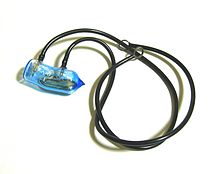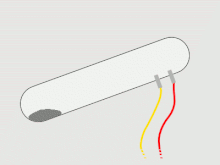Mercury switch
A mercury switch is a switch that makes contact with mercury .
Among electrical engineers smaller versions are also these switches for appearance mercury pig called.
Layout and function

Hermetically sealed, usually in a glass tube, under a protective gas , these switches contain metallic power leads and a small amount (approx. 0.1 to 3 milliliters) of mercury. The electrically conductive metal, mercury, which is liquid at room temperature , closes the circuit depending on its position.
Mercury tilt switches react to changes in position. This is used for position sensors or for switching. The function's dependence on position and vibration is a disadvantage here.
Mercury switches and relays are extremely reliable and can switch large amounts of power (up to 16 A at 230 V ~ mains voltage are common). A disadvantage is the function's position and vibration dependency.
The longevity of mercury switches, even with frequent switching of large loads, is based on the fact that there is no contact wear, especially if the contact pair is made of mercury on both sides due to suitable ceramic fittings in the container. Both metallic power supply lines are constantly surrounded by mercury and do not work as switching contacts themselves.
In principle, contact thermometers are also mercury switches, but are not designated as such. You can only switch small loads.
use
Mercury switches were previously used as inclination sensors, in older time relays , in drop stirrups , in automatic staircase lighting and pressure switches ( level measurement in a water pump control with a boiler).
The interior lighting of freezers was also switched on with a mercury tilt switch in the lid.
Mercury switches are occasionally still used in anti-theft devices (tilt detectors ) and alarm systems , but they are already being replaced by electronic sensors and switches based on semiconductors . There were also record players in which the drive motor was switched off by a mercury switch moved by the tone arm when the end position was reached. There are also switches with switch contacts wetted with mercury. However, these are usually not referred to as mercury switches.
In some bombs there is a mercury switch in the electrical ignition circuit to close the ignition circuit in the event of a change in position or acceleration and thus ultimately trigger the explosion of the bomb. In some landmines , a mercury switch is part of the anti-lift system.
In the first affordable coffee machines for private households, bimetals were still in use until the mid-1960s , which influenced the inclination of a mercury switch. Later "real" - and considerably cheaper - bimetal switches replaced this technology.
In the 1980s, mercury switches were built into the first motion-sensitive control devices for computers. There were, for example, some joystick models that were tilt-sensitive and, because of the mercury switches, managed without microswitches or potentiometers. They are considered to be the fundamental forerunners of motion and acceleration-sensitive controllers, such as those used on Nintendo's Wii console.
Environmental relevance
Due to the toxicity of mercury when broken and the associated problems when disposing of old electrical devices, mercury switches are rarely used. In order to reduce the risk of the glass tube breaking and thus of the escape of mercury, mercury switches have recently been often additionally surrounded by a plastic capsule. Since March 2005, mercury switches may only be used in exceptional cases due to the RoHS regulation.
Mercury switches can now be replaced by mercury-free alternatives. An example is a metal ball that closes a pair of contacts depending on its position. However, it has no comparable contact load capacity. Another possibility is to replace the mercury with other liquids. Other alternatives are micromechanical-electronic acceleration sensors .
literature
- Günter Boy, Horst Flachmann, Otto Mai: The master's examination in electrical machines and control technology. 4th edition, Vogel Buchverlag, Würzburg, 1983, ISBN 3-8023-0725-9
- Günter Springer: Expertise in electrical engineering. 18th edition, Verlag - Europa - Lehrmittel, Wuppertal, 1989, ISBN 3-8085-3018-9
Web links
Individual evidence
- ↑ Inclination sensor in old Soviet aircraft


